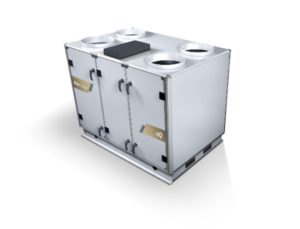Since the introduction of the Energy related Products (ErP) regulations, the need to improve the efficiency of air-handling solutions has driven demand for commercial heat-recovery units that can fit increasingly tighter space, budgets and project timescales. With these factors having an influence on purchasing decisions, Jibin Kurian discusses the benefits of ‘off-the-shelf’ solutions…
Before the ErP legislation was introduced, heat-recovery technology was often an option to accompany air-handling units in commercial applications. Nowadays, the requirement of complying with energy-efficiency standards means that heat-recovery units with air treatment capability are the norm. But as costs, timescales and space for new and retrofit projects become increasingly squeezed, specifiers are looking to off-the-shelf solutions to address these challenges.
 SIMPLE AND STANDARDISED
SIMPLE AND STANDARDISED
For projects where a simple rather than a bespoke system fits the bill, it is possible to choose an off-the-shelf heat-recovery unit, provided the airflow rate required is known. This negates the need for a technical expert to get involved in the design stage along with complex calculations and specifications, thus simplifying the procurement process.
Lead times for standardised products are also shorter, enabling manufacturers to deliver their units to fit tight project timescales. Once on site, installation is also much easier. When a project is completed, system designs and project processes featuring the same standardised heat-recovery unit can be replicated for similar developments further down the line.
The new range of standardised heat-recovery units that cater to 0.1 up to 6 m3/s typically come fully packaged with controls that are compatible with any central BMS. They are all designed to ‘plug and play’ with no further programming required – so after the units have been installed, only air balancing and controls commissioning needs to be carried out on site.
SPACE SAVING
As lettable space increasingly becomes a premium in commercial buildings, architects and designers are coming under pressure to allocate minimal area for heat-recovery units and their associated ductwork. This is where the new range of units score. They comes with a plate heat exchanger, offering up to 85% heat recovery. A compact design ensures the units can be installed into ceiling voids and be connected to existing infrastructure in that area.
The units typically accommodate all the circular connections on the short sides, plus lend themselves to be taken through the existing doorways with ease, making it easy to install them, thus saving, project time as well as space.
Where there is no internal space for the heat-recovery units, or when there is dedicated plant area on a building rooftop, the products are suitable to be located externally. These units come with high strength, anti-corrosive mechanical construction suitable for external mounting with a pitched roof.
LOW NOISE
Apart from space, other site requirements should not be overlooked, either. For example, educational institutions often require low noise levels to maintain an optimum learning and teaching environment. With a maximum noise level of 20dB at 3m, the units emit the lowest noise levels in the market.
CONCLUSION
With energy efficiency and IAQ currently at the top of the regulatory agenda, it is important for HVAC professionals to stay up to speed with the latest developments. By specifying off-the-shelf heat-recovery units, designers can deliver ‘fresh’ air even where natural ventilation is not an option, whilst meeting space and project timescale requirements.
Copyright © 2006-2025 - CPI Industry. All rights reserved.